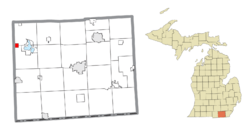Addison, Michigan facts for kids
Quick facts for kids
Addison, Michigan
|
|
|---|---|
|
Village
|
|

Looking west along Main Street toward US 127
|
|

Location within Lenawee County
|
|
| Country | United States |
| State | Michigan |
| County | Lenawee |
| Townships | Rollin and Woodstock |
| Incorporated | 1893 |
| Area | |
| • Total | 1.00 sq mi (2.59 km2) |
| • Land | 0.95 sq mi (2.47 km2) |
| • Water | 0.04 sq mi (0.11 km2) |
| Elevation | 1,066 ft (325 m) |
| Population
(2020)
|
|
| • Total | 573 |
| • Density | 600.00/sq mi (231.57/km2) |
| Time zone | UTC-5 (Eastern (EST)) |
| • Summer (DST) | UTC-4 (EDT) |
| ZIP code(s) |
49220
|
| Area code(s) | 517 |
| FIPS code | 26-00380 |
| GNIS feature ID | 2397912 |
Addison is a small village located in Lenawee County, in the state of Michigan, USA. In 2020, about 573 people lived there. It sits right on the border between Rollin Township and Woodstock Township.
Contents
Exploring Addison's Location
Addison is a small village covering about 1 square mile (2.59 square kilometers). Most of this area is land, with a tiny bit of water.
Addison's Past: A Brief History
Early Days and First Settlements
Addison's story began in 1834. A man named John Talbot settled near a winding creek. At that time, the area was a huge forest with many blue lakes. The Potawatomi people lived there.
In late 1835, Talbot built a simple grist mill along Bean Creek. A grist mill grinds grain into flour. This was the start of the settlement, which was first called "Manetue."
Changing Names and New Beginnings
Talbot later moved the settlement to where Addison is today. He restarted his milling business by the fall of 1836. By 1838, the town was renamed "Peru." Over the years, it had several other names.
Finally, in 1851, the name "Addison" was put on maps. This name came from Addison J. Comstock. He was a banker from Adrian, Michigan who bought a large part of the town. The village officially became an incorporated village in 1893.
Growth with the Railroad
In 1883, the railroad came to Addison. This was a big deal! It helped Addison's local economy grow a lot. Many new businesses opened. A three-story hotel was built for visitors.
The Addison Courier newspaper started in 1884 and ran for 76 years. The railroad brought good times to Addison, even after the trains stopped running through the village.
Modern Addison: A Quiet Village
One of Addison's old landmarks, a grist mill built in 1848, was removed in 1980. Even though the village faced some economic challenges in the late 1900s, people still celebrated its history.
In 1984, they had a big 3-day celebration for its 150th anniversary. In 2009, they celebrated the 175th anniversary. Today, Addison is a quiet village. It has about two dozen businesses and institutions.
Local historians have written books about Addison's past. Alice Slocum wrote a small booklet in 1976. Dan Cherry published an illustrated book in 1997, and a follow-up in 2013.
In August 2014, Addison got its own radio station, WQAR-LP "Q95 the Panther" at 95.7 FM. Students from Addison Community Schools own and run the station, playing classic rock music.
Addison's Population Over Time
| Historical population | |||
|---|---|---|---|
| Census | Pop. | %± | |
| 1880 | 291 | — | |
| 1890 | 425 | 46.0% | |
| 1900 | 470 | 10.6% | |
| 1910 | 474 | 0.9% | |
| 1920 | 416 | −12.2% | |
| 1930 | 452 | 8.7% | |
| 1940 | 465 | 2.9% | |
| 1950 | 488 | 4.9% | |
| 1960 | 575 | 17.8% | |
| 1970 | 595 | 3.5% | |
| 1980 | 655 | 10.1% | |
| 1990 | 632 | −3.5% | |
| 2000 | 627 | −0.8% | |
| 2010 | 605 | −3.5% | |
| 2020 | 573 | −5.3% | |
| U.S. Decennial Census | |||
Who Lives in Addison? (2010 Census)
In 2010, 605 people lived in Addison. There were 245 households and 156 families. The village had about 630 people per square mile.
Most residents (97.0%) were White. A small number were African American (0.5%) or from other backgrounds. About 1.0% of the population was Hispanic or Latino.
Many households (35.9%) had children under 18. About 42.0% were married couples. The average household had 2.47 people, and families had 3.06 people.
The average age in the village was 35.1 years old. About 26.8% of residents were under 18. About 10.7% were 65 or older. There were slightly more females (53.2%) than males (46.8%).
Getting Around Addison
- US 127 (also known as Steer Street) crosses Main Street in Addison.
Famous People from Addison
- Maxine Kline: A professional baseball player from the 1940s. She grew up in Addison.
- Joseph H. Steere: He was born in Addison and became the Chief Justice of the Michigan Supreme Court.
- Nick Smith: A retired politician who was born in Addison. He graduated from Addison High School in 1953. He served in local, state, and national government.
- John Randolph Bray: An early animator. He lived in Addison as a child because his father was a minister there.
Images for kids
See also
 In Spanish: Addison (Míchigan) para niños
In Spanish: Addison (Míchigan) para niños





